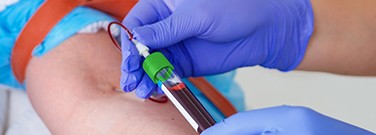Phlebotomist

By Christina Hooton
Phlebotomists collect blood for donation or testing, so it can be analyzed to help diagnose illness, gauge medication effectiveness, or assess patient nutrition. To extract blood, they typically use a process called venipuncture. They apply a tourniquet to the patient's upper arm, use an alcohol swab to disinfect the area, locate a vein near the inside of the elbow, and insert a needle. Skin puncture, which involves pricking a finger, tests the patient's blood sugar or determines blood type.
Key responsibilities include:
- Blood collection
- Sanitization of all equipment
- Accurate labeling
- Proper storage
- Careful transport
Work Environment
Clinical laboratories, hospitals, doctor’s offices, and blood donation centers employ phlebotomists. A clinical laboratory technologist or another medical professional at one of these facilities is typically their supervisor.
Core Skills
Because many patients are afraid of needles, a phlebotomist must be able to put their patients at ease and handle difficult and sometimes emotional patients. They must rely on their fine motor skills to successfully insert a needle into a vein.
Accuracy and safety are of the utmost importance. Several infectious diseases can be transmitted through blood contact. Therefore, misidentification and contamination of a blood sample can have serious consequences. A phlebotomist may take dozens of blood samples during a typical shift. So, they must be well-organized and have excellent attention to detail.
Academic Requirements
Phlebotomists must have a high school diploma or GED and complete an accredited training program at a community college or vocational school. The National Accreditation Agency for Clinical Laboratory Sciences accredits phlebotomy programs. Training involves the study of anatomy, blood collection procedures, proper storage and handling of blood samples, and safety precautions.
Licensure and Certification
Many employers require certification, and some states may require licensure. The National Phlebotomy Association certifies phlebotomy technicians. Before taking the exam, you must have completed an Allied Health Program with 200 hours of training, including clinical experience.
Job Outlooks and Salaries
According to the U.S. Bureau of Labor Statistics, the phlebotomy job market is expected to grow by 22 percent from 2020 to 2030. That’s a much faster rate than most occupations. Over the next decade, there are expected to be an average of 19,500 job openings each year. In May 2020, the median annual wage for phlebotomists was $36,320.
Opportunities for Advancement
Phlebotomists can advance their careers by specializing in a specific area, fulfilling a managerial position, transitioning to become a registered nurse, working in a medical laboratory, or becoming a physician assistant. Specialties include:
- Registered phlebotomy specialist
- Collections phlebotomy specialist
- Traveling phlebotomist
- Donor phlebotomy technician
Additional education, training, and certifications may be required.
How Can I Prepare Myself?
To prepare for a career in phlebotomy, take high school courses in health, science, and psychology. Research phlebotomy programs and their requirements and find volunteer opportunities in laboratories.
To learn more about phlebotomy careers, visit: